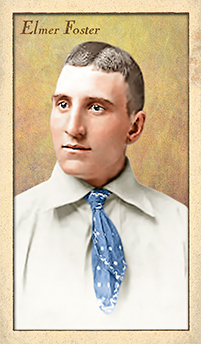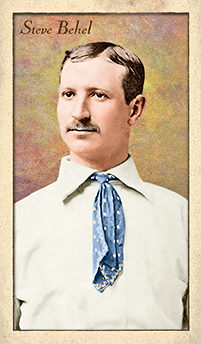
- Series: 1880s: Spotted Ties
- City: New York
- Team: Metropolitans
- League: American Association
Stephen Arnold Douglas Behel (1860-1945) had a life that spanned a remarkable period, from the eve of the Civil War to nearly the end of World War II. He only spent a few years out of those nine decades in professional baseball, but he could tell his grandchildren about how he was once a big league player.
Behel saw action in nine games in 1884 for the Milwaukee Brewers of the upstart Union Association, which had poached players from the dominant National League, the American Association and minor league teams. The UA managed to limp through that one season at the pinnacle of the game, though many decry the notion that it was truly a major league. The Brewers only played a dozen games in '84 as a replacement franchise late in the season along with the St. Paul Saints. The Saints never got to play a home game and the Brewers (aka Cream Citys) played only one on the road. Steve went 8 for 33, good for a .242 average which was third on the team.
Behel was a part-timer for the AA's NY Metropolitans in 1886, playing in 59 games, but his average slipped to .205. Primarily a minor leaguer, Behel began with the Fort Wayne Hoosiers of the Northwestern League in 1883 and concluded with Rockford of the Central Interstate League in 1888. His best season was with Eau Claire, where he batted .348 in 1887.
- The Earlville, IL native played most of his pro ball close to home, but he did get further afield with the Augusta Browns of the Southern League in 1885
Auction History
Cartophilia
Old Judge Pose: 26-1
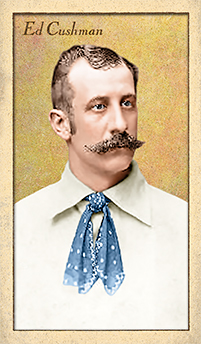
- Series: 1880s: Spotted Ties
- City: New York
- Team: Metropolitans
- League: American Association
Edgar Leander Cushman (1852-1915) was a left-handed pitcher with a less-than-stellar career record of 62-80 despite a sub-4.00 ERA. He was at times brilliant, as witnessed by his performance in his second year in the majors. Cushman had gotten into a handful of games for the Buffalo Bisons in 1883 and returned to the “big leagues” at the end of the '84 season with the Union Association's Milwaukee Brewers, themselves a late-season replacement in the by then moribund league. Ed was dazzling. In the team's second UA game, he hurled the league's second (and final) no-hitter on September 28 against the Washington Nationals. In his next start Cushman nearly duplicated his feat, only surrendering a sole hit in the ninth inning of another shut-out against the Boston Reds. He caught the attention of American Association owners and was signed by the Philadelphia Athletics for '85. Ten starts later Cushman found himself moved north to the New York Metropolitans. Late in that campaign Ed struck out eight straight Alleghenys. The Mets named Cushman Pitcher of the Year for both the 1885 and '86 seasons. After returning to the minors in 1888, Ed got one last shot in the majors when Charlie Morton gained entry into the AA for his Toledo Maumees for their only major league season, 1890. Ed had moved out to Morton's Des Moines team in the Western Association and Morton kept him when he took over the Toledo franchise.
- Cushman's strongest year was 1886 for New York. He hurled 325 innings, going 17-21 with a fine 3.12 ERA
Auction History
Cartophilia
Old Judge Pose: 107-1
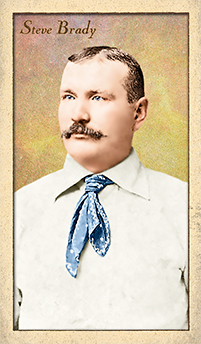
- Series: 1880s: Spotted Ties
- City: New York
- Team: Metropolitans
- League: American Association
Stephen A. Brady (1851-1917) was born in Worcester, MA and began playing professional ball in New England in the early days of the sport's arrival on the national scene. Brady started out with the Hartford Dark Blues of the pre-modern majors - the National Association of Professional Base Ball Players. The NAPBBP had become the first openly pro league in 1871 and Steve joined the fraternity the same year the Hartfords did, 1874.
Seven eastern seaboard clubs plus Chicago made up the circuit that year. Owned and organized by Morgan Bulkeley and anchored by the likes of Cherokee Fisher, Bob Addy, Orator Shafer and Lip Pike, Hartford’s Dark Blues disappointed and dwelt near the cellar in 1874, finishing with a 16-37 record as the Boston Red Stockings continued their dominance. Rookie Brady did well in a utility role however, contributing a .314 average in 27 games to an otherwise dismal season.
Brady would play only one game for the Dark Blues in 1875 before being shipped off to the Washington Nationals. The move was likely regrettable for him professionally. The Nationals would go 5-23 and bankrupt while his former Dark Blues dominated at 54-28 on the strength of contributions from a few newly acquired superstars. Tommy Bond and Candy Cummings won those 54 games with a combined ERA of 1.56 while the team, including recently acquired sluggers Black Jack Burdock and Tom York, flourished under the leadership and defensive wizardry of new player/manager Bob “Death to Flying Things” Ferguson.
Meanwhile, Brady’s performance in Washington mirrored his team’s: he floundered with a .143 batting average for a club that produced a .179 winning percentage. The minors soon beckoned and Steve played for NY and MA clubs, including the Metropolitans whom he joined for the 1881 season in the Eastern Championship Association. The team moved to the League Alliance and, in '83, ascended to the American Association, returning Brady to the majors through 1886. Moved to the outfield in '84, Steve's offensive production stabilized and he batted .264 over his tenure in NY. By 1887 Brady's old Hartford team was now in the Eastern League when he rejoined them for a very successful season, hitting .350.
- Per Wikipedia: Brady’s 1875 Washington Nationals "went out of business in St. Louis, Missouri, after playing the local Red Stockings on July 3 and July 4. Next day the players announced by telegraph that a club official had absconded with the funds but (Ryczek 1992: 194) concludes that "the tale had been planted by the players in an effort to find enough good samaritans to foot the bill for the trip home." The club probably failed by "unappealing play" and consequent receipts too small to support travel. On the final trip, they lost two in Philadelphia and five of six in St. Louis. The final game was a 12-5 victory but the two local teams outscored Washington 42-5 in the first five games, which must have been repelling."
Auction History
Cartophilia
Old Judge Pose: 39-1
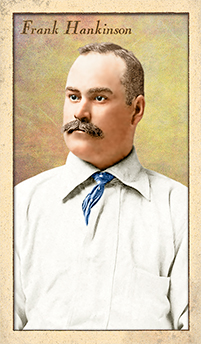
- Series: 1880s: Spotted Ties
- City: New York
- Team: Metropolitans
- League: American Association
Frank Edward Hankinson (1856-1911) was a third baseman for four early National League clubs before ending his major league tenure with two American Association teams. Just why he was, primarily, a third baseman is a bit of a head scratcher. Frank debuted with the Chicago White Stockings in 1878 and hit a respectable .267 (an average he wouldn't exceed for a decade). Manager Bob "Death to Flying Things" Ferguson did start young Hankinson on the mound one time that rookie season, a complete game loss with the pitcher surrendering six runs. Ferguson must have seen something he liked as he used Hankinson much more in '79. As the back-up to Terry Larkin, Frank went 15-10 with an ERA nearly matching the ace (2.50 vs. 2.44 for Larkin). Perhaps it was Hankinson's anemic .181 BA that made him more desirable as a pitcher but, for unknown reasons, that would be basically a one-and-done “career” as a hurler in the majors. Thereafter, Hankinson labored as a NL part-timer mostly at third, although he played all positions but catcher over his ten-year span. His move to the AA saw him get many more plate appearances, especially with the Metropolitans from 1885-87.
- Overall, Hankinson hit .228 but compiled an impressive 16-12 record on the mound, completing all his starts and throwing two shut-outs. His ERA was 2.50.
- He closed out his career with '88's last-place Kansas City Cowboys, hitting a lifetime low .174
Auction History
Cartophilia
Old Judge Pose: 211-1
- Series: 1880s: Spotted Ties
- City: New York
- Team: Metropolitans
- League: American Association
Elmer Ellsworth Foster (1861-1946) was primarily an outfielder with the New York Metropolitans, New York Giants and Chicago Colts over a six year span beginning in 1886. The very rare baseballer who threw left and batted right, Foster achieved a career batting average of .187.
- One of the first five major leaguers born in Minnesota
- Played at Haverhill with future Hall of Famers Wilbert Robinson and Tommy McCarthy
- Noted for his speed on the base paths, Foster always had an explanation if caught stealing: “Why, I wasn’t a bit tired. Why should I have stopped running?”
Auction History
Cartophilia
Old Judge Pose: 168-1




